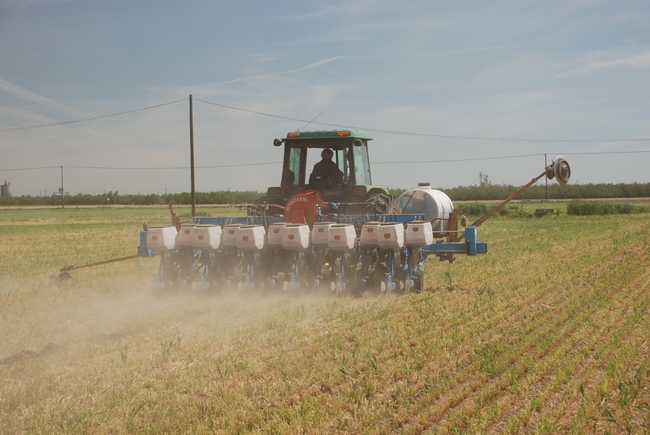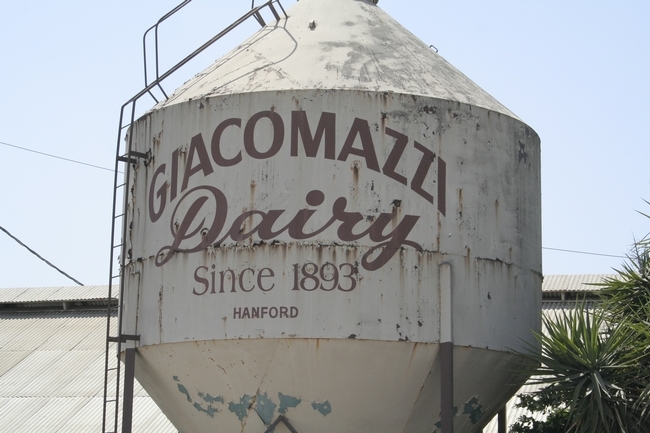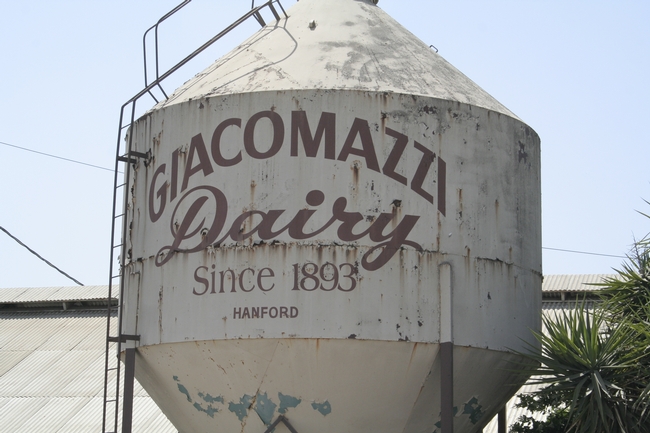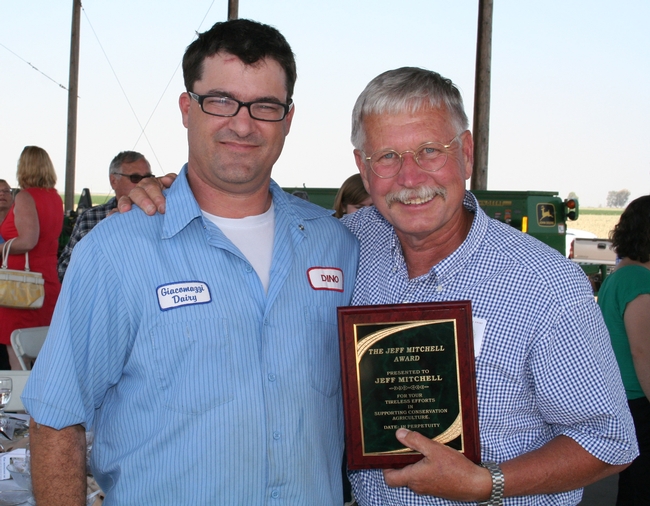Conservation agriculture news
Travels along Elkhorn Avenue
For the past 20 years, I have taken Elkhorn Avenue just about every day from my home in Kingsburg out west to the small town of Five Points where I work. My travels along this 30-mile rural route have been one of life’s little joys as I have come to deeply respect the people I have met and the things I’ve seen along the way. In many ways, Elkhorn Avenue represents the very best of our Valley and it provides a lot that we might all be proud of.
Driving along Elkhorn gives the opportunity to see a number of natural as well as technological gradients. Leaving Kingsburg, you’ll first notice the light-colored, sandy soils that derive from the Sierra Nevada range flanking the eastern San Joaquin Valley. Then, once you cross the trough of the Valley out beyond Riverdale, the soils transition to darker, more finely-textured clay loams that formed as alluvial fans from the Coast Range mountains to the west. These deep soils provide an important part of the natural resource base that has enabled the region’s phenomenal agricultural productivity over the past century.
Our Valley’s crop diversity is also apparent along this transition. On a recent drive this spring, I counted over 30 different crops being produced. From permanent trees and vines including almonds to walnuts, to diverse annual crops ranging from eggplant to wheat, a rich array of cropping can be seen along Elkhorn year round.
Different innovative systems are now used to irrigate these crops. Flood and furrow irrigation systems have been replaced in vineyards by drip and in orchards by micro-sprinkler systems and recently in annual crop fields by highly precise and uniform center pivot systems that can be seen at the dairy farm of John and Joann Tachara just east of Burrel. Their silage fields are now irrigated and fertigated to precisely match crop needs.
Traveling along Elkhorn also brings to mind other innovative farmers. A few miles south on 6th Avenue is Giacomazzi Dairy, a small farm operated by the Giacomazzi family since 1893 and currently run by Dino Giacomazzi, the California recipient of the 2012 prestigious Leopold Conservation Award. The conservation agriculture practices that Dino has pioneered greatly reduce tractor passes across his fields resulting in more efficient and economical production with fewer emissions. A true example of sustainability if ever there was one.
Further west and south of the small West Side community of Five Points is Red Rock Ranch, owned and managed by John Diener. In 2011, John received the Leopold Award for the many conservation techniques he uses to manage salty drainage water, achieve on-farm energy self-sufficiency by biofuel production and processing, and couple conservation tillage with center pivot irrigation. Another example of visionary and sustainable farming.
You may also notice smaller scale innovations along Elkhorn Avenue. A group of boys just west of Hwy 43 created their own soccer field complete with metal goal posts. They do all the maintenance for this field themselves and it has become a well used local resource. I also remember seeing two young girls having the times of their lives in their 50-gallon plastic drum ‘pool’ that they had filled with a garden hose. The fun they were having that day with this makeshift little pool brings a smile to my face even today.
The term “innovation” is sometimes overused, but from what I’ve seen through my travels along Elkhorn Avenue, it sure seems to apply to this place. “Innovation” not only means creating something new; it’s also about bringing something that exists elsewhere to a new place - and that is definitely happening here
Looking forward, the future of the agricultural systems that are evolving along Elkhorn Avenue ought to be quite bright. That is, of course, if the region’s other necessary resource, - water, - is made more reliable and available. Creative and visionary water policies and expanded development of efficient water capture, storage, and delivery infrastructure are going to be needed for this innovation to continue. The future of Elkhorn Avenue’s dynamic innovation thus rests with all of us. May we act wisely.
CASI representatives visit with ASI and ANR in Davis
Nine representatives of the Conservation Agriculture Systems Innovation (CASI) Center recently met with leaders of two important University of California groups on the UC Davis campus to introduce CASI initiatives and to seek closer collaboration between CASI and these partner UC groups.
On June 27, the group met with six members of the UC Davis Agricultural Sustainability Institute, including director Tom Tomich, associate director Kate Scow along with Sonja Brodt, Emma Torbert, Israel Hererra, Bev Ransom and Mark Van Horn.
On the following day, CASI met with ANR vice president Barbara Allen-Diaz, associate ANR director Bill Frost and strategic initiative leader Doug Parker. UC Davis associate dean Jan Hopmans also took part in the ASI meeting and UCB Soil Science Professor, Garrison Sposito, participated in the ANR session.
CASI members taking part in these exchanges included Monte Bottens, Ron Harben, Dan Schueler, Alan Wilcox, Dan Munk, Ladi Asgill, Michael Crowell, Rick Hanshew, Molly Reick, and Jeff Mitchell. This group represented a strong cross-section of CASI membership and provided a very comprehensive introduction to the work and expansion goals of our Center. Both meetings yielded opportunities for future follow-up discussions that will hopefully be aimed at more specific collaborations.
In addition to these meetings, the CASI team also had a very good opportunity to reconnect with Greg Gibbs, development director of UCD’s College of Engineering for an insightful and helpful discussion on our fundraising efforts. Greg has been working with our core CASI group for over two years and has greatly helped us prepare and refine our development effort.
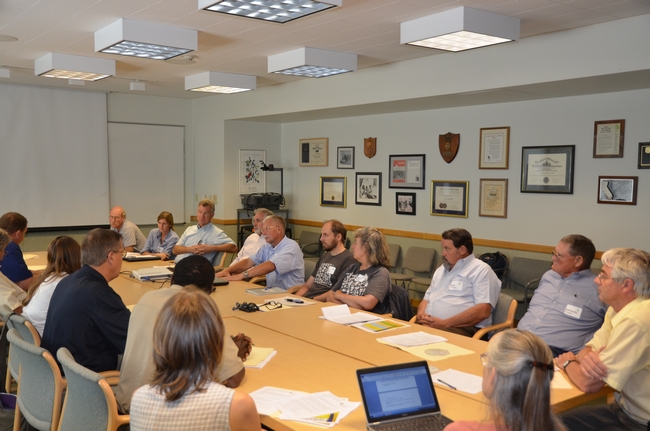
CASI team discussion with members of the UC Davis Agricultural Sustainability Institute.
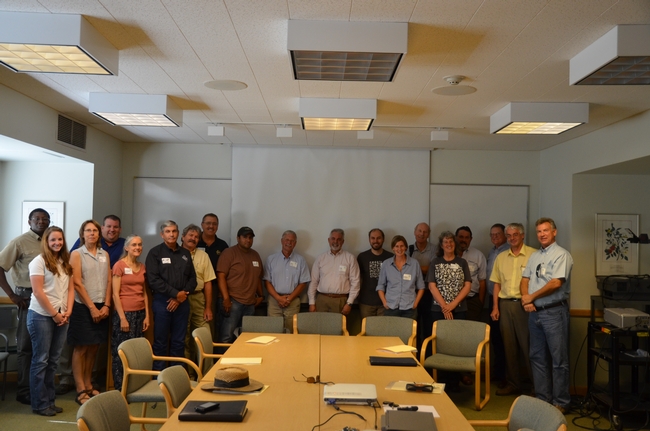
CASI team members and ASI hosts with UCD Associate Dean Jan Hopmans.
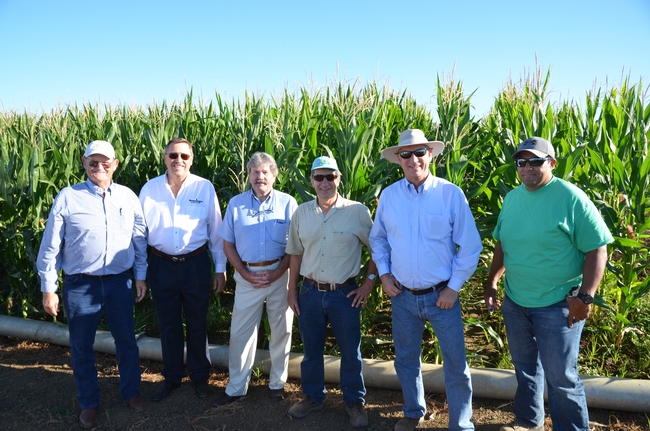
CASI members hosted by Martin Burger and Israel Hererra of the Long-Term Research on Agricultural Systems (LTRAS) Project.
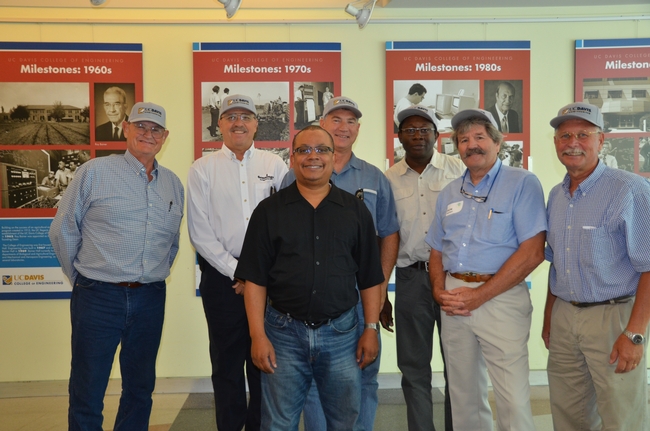
CASI team members with College of Engineering Development Office director, Greg Gibbs.
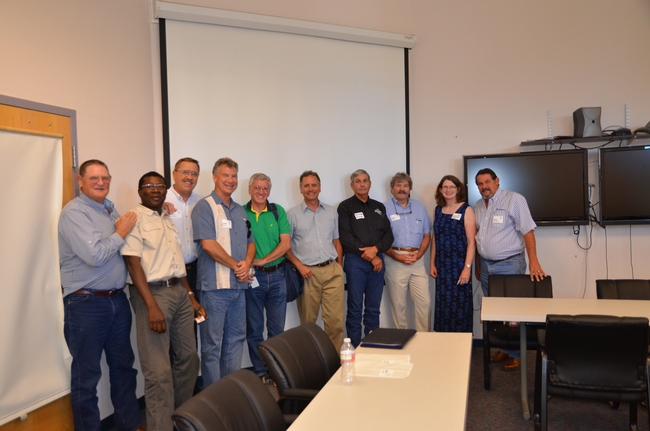
CASI team meeting with UC ANR vice president Barbara Allen-Diaz, associate director Bill Frost and strategic initiative leader Doug Parker.
2013 No-till Cotton Production Field Day May 30
9:00 a.m.
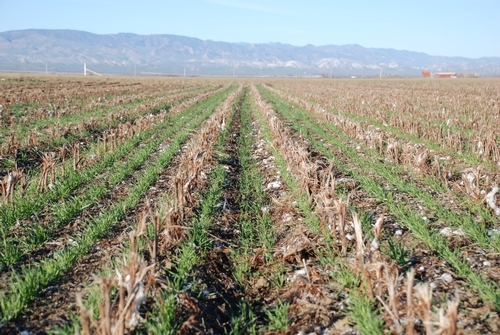
Cover crop growing in cotton and tomato residues.
Leopold Conservation Award winner shares honor with the agricultural industry
The timeworn water tower that stands in front of the Giacomazzi Dairy in Kings County is a hallmark of the farm’s endurance. It proclaims, “Since 1893.”
Dino Giacomazzi, the fourth generation to run the operation, said cows have been producing milk and the land producing feed every single day of the ensuing 120 years.
In order to maintain the family business in times of mounting environmental pressures and tightening economics, Giacomazzi became a leader in developing completely new production paradigms for dairy industry feed production in the San Joaquin Valley.
Last year, he received the prestigious Leopold Conservation Award for California, and last week he hosted a luncheon at his rural Kings County dairy to raise awareness of efforts being made around the San Joaquin Valley to boost agricultural sustainability.
“I want this to be about all the work being done here. I am accepting this award on behalf of a whole industry of people,” Giacomazzi said. “Every farmer I know is a conservation agriculturist. That’s just called doing business.”
In California, the Leopold Conservation Award is presented by the Sand County Foundation, California Farm Bureau Federation, and Sustainable Conservation. The recognition, said Karen Sweet of the Sand County Foundation, “honors ethical and scientifically sound practices that benefit us all, and inspires other landowners as an example.”
Giacomazzi, a founding member of UC’s Conservation Agriculture Systems Innovation (CASI) Center, for years has evaluated equipment, planting configurations and fertilization approaches in silage production. He worked closely with other dairy operators to build a reservoir of knowledge and experience that is accelerating the development and implementation of conservation tillage practices, said Jeff Mitchell, UC Cooperative Extension specialist in the Department of Plant Sciences at UC Davis and chair of CASI.
“Dino’s a person of tremendous vision for seeing a better way and for, as he is fond of quoting Abraham Lincoln, ‘thinking anew and acting anew,’” Mitchell said. “He’s a rather unique example of someone who has had the courage to disenthrall himself of dogma and create something new.”
In the spring of 2005, Giacomazzi initiated a demonstration evaluation of strip-till corn planting in a 28-acre field as part of an Environmental Quality Incentives Program contract he had received from the USDA Natural Resources Conservation Service. In 2006, he hosted a public field day to share what he learned about strip-till implements, planters and configurations, an event Mitchell considers the best public field day of his Extension career. Giacomazzi has traveled to Davis to address agriculture students, accepted speaking engagements -such as the keynote address at the launch of CASI last year - and hosted numerous agricultural tours on his farm.
“Dino is a leader,” Mitchell said. “He has opened a lot of eyes to what can be, to how agricultural systems can be improved, to both make money and to be good for the environment.”
During the celebration, Giacomazzi took to the podium to turn the spotlight on Mitchell. Giacomazzi praised Mitchell’s personal commitment to sharing conservation agriculture practices.
Recognizing Mitchell's distinct character and energy, Giacomazzi said he could think of no more fitting way to honor him than with a customized "Jeff Mitchell Award," which he said Mitchell would hold "in perpetuity."
Another founding member of CASI, Ron Harben, former field officer for the California Association of Resource Conservation Districts, also spoke at the event.
“Jeff’s enthusiasm is contagious,” Harben said, “but it’s solidly backed up with knowledge, experience and the real desire to bring sustainability – both economic and environmental – to agriculture.”
Mitchell travels in the Valley extensively, visits farms from Kern County to as far north as the Intermountain area on the border with Oregon, and takes two or three trips from his Fresno County headquarters to Davis each week for meetings, teaching classes and working with graduate students.
“His Toyota Prius has nearly half a million miles on it,” Harben said.
During his presentation at the celebration, Mitchell also called attention to the Giacomazzi Dairy’s weathered water tower.
“Think about that. There is something quite profound here,” he said. “There is no better example of sustainability. This is where sustainability is happening. This is the real thing.”
The Sand County Foundation, its major partners, California Farm Bureau Federation and Sustainable Conservation, and its other sponsors, S. J. Bechtel, Jr. Foundation, The Nature Conservancy and Farm Credit, are accepting nominations for the 2013 Leopold Conservation Award until July 12. Nominations of agriculturalists and foresters may be submitted at the Leopold Conservation Award website, http://www.leopoldconservationaward.org.
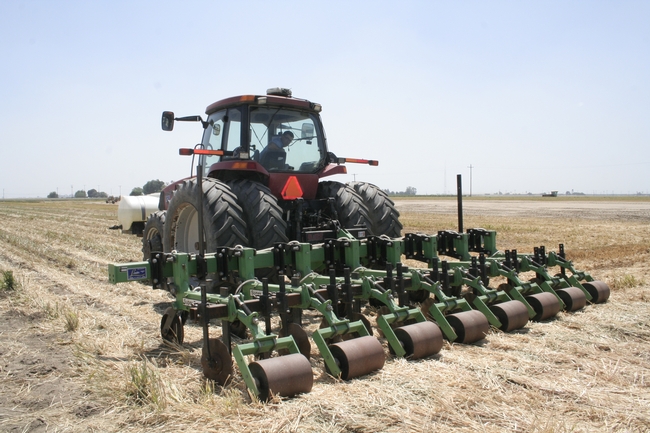
Giacomazzi demonstrates strip-tillage at the Leopold Conservation Award celebration.
See conservation agriculture research in 'real time'
Farmers and others interested in new irrigation technologies and conservation agriculture can follow along on their computers in real time as research unfolds at the UC West Side Research and Extension Center. The Conservation Agriculture Systems Innovation (CASI) Center is the site of a comparison trial involving no-till wheat and minimum-till onion production with buried drip irrigation and overhead irrigation. Both crops were established with overhead irrigation.
Crop growth and development, irrigation amounts and soil water storage are being carefully monitored throughout the season. This year, the research is also looking at whether the water holding capacity of our no-till soils has actually increased, which might be another advantage of this conservation agriculture approach. Another important goal of this work is to evaluate and develop sensor-based irrigation strategies.
Two types of soil water sensors are being used: granular matrix Watermark tension sensors and Decagon ECO-5 sensors to measure soil volumetric water content.
Real-time data from these sensors in the 2013 onion field may be accessed by logging onto
with the following username and password
ucdavis1234
Sensor 5G0D1904 is for the overhead system and 5G0D1905 is the drip treatment. By clicking on the name of one of these sensors, you can follow soil volumetric water content for each of the following depths: P1 (6”), P2 (12”), P3 (24”), P4 (36”) and P5 (48”).
To access soil water tension data being collected by the Watermark granular matrix sensor, log on to
with the following username and password
ucdavis
ucd1234
Once inside this site, click on ‘Main Soil Moisture Data Page.’ Then, click ‘UC Davis 900M.’ There, you can view soil temperature and soil water tension readings for 6” (WM1 and WM2), 12” (WM3 and WM4), 24” (WM5 and WM6), 36” (WM7), and 48” (WM8).
This new window to our research follows several years of efforts to develop enhanced water and crop management systems for a range of crops commonly produced in the central San Joaquin Valley. This work has focused on the coupling of advanced sustainability technologies — such as precision overhead and subsurface drip irrigation systems with strip-till and no-till planting to achieve cheaper and more sustainable systems.
Working with colleagues at Valmont Industries headquartered in Omaha, Neb., who provided the eight-span overhead irrigation system for research and education use by the CASI Center, this team of researchers and farmers has found that the irrigation water application uniformity, or ‘Christiansen’s Uniformity,’ for the overhead system is 93 percent, indicating an excellent level of application consistency.
The Five Points research team is working to merge the many proven benefits of overhead irrigation, including labor, cost and water savings, and couple them with additional benefits derived from preserving high amounts of surface crop residues. Work conducted by the team has already shown that roughly 13 percent, or 4 inches of soil water evaporation, can be eliminated and saved in the soil during a typical summer season when a thick mat of residues is on the soil surface. Our goal, is to follow in the steps of legendary South Dakota State University researcher Dwayne Beck and the no-till farmers he works with to essentially ‘take the E out of ET,’ thereby having more water go through plant transpiration leading to crop growth rather than evaporation.

Planting onions in field comparison study of overhead and drip irrigation at the University of California’s West Side Research and Extension Center in Five Points, Calif.

